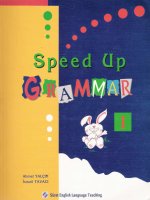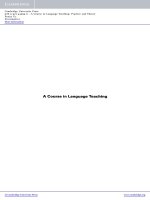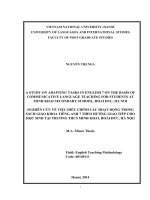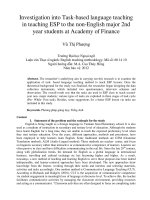TEFL=English language teaching methodology
Bạn đang xem bản rút gọn của tài liệu. Xem và tải ngay bản đầy đủ của tài liệu tại đây (243.35 KB, 24 trang )
TEFL=ENGLISH LANGUAGE TEACHING
METHODOLOGY
ENGLISH LANGUAGE TEACHING
METHODOLOGY
TEFL Methodology that lists definitions for
,concepts such as methodology, approach
method, curriculum/syllabus and
.technique
? What are principles of language learning
" How and why should overall "principles
?guide our teaching
ENGLISH LANGUAGE TEACHING
METHODOLOGY
Detailed summaries of various language
teaching methods developed and used over
the past century, including the Grammar
Translation Method, the Direct Method, the
Audio-lingual Method, Community Language
Teaching, the Silent Way, Suggestopedia
,Total Physical Response, and the Natural
Approach. For each method there is an
explanation of objectives, key features,
typical techniques and also some
comments/critiques from English Raven
.based on personal experience/opinion
WE WILL TALK ABOUT THE
:FOLLOWING
The Grammar Translation Method-1
The Direct Method-2
The Audio-lingual Method-3
Community Language Learning-4
THE GRAMMAR TRANSLATION
METHOD
THE GRAMMAR TRANSLATION-1
METHOD
Latin and Ancient Greek are known as
"dead" languages, based on the fact
that people no longer speak them for
the purpose of interactive
communication. Yet they are still
acknowledged as important languages
to learn (especially Latin) for the
purpose of gaining access to classical
,literature
THE GRAMMAR TRANSLATION
METHOD
Latin has been studied for centuries, with the
prime objectives of learning how to read
classical Latin texts, understanding the
fundamentals of grammar and translation,
and gaining insights into some important
foreign influences Latin has had on the
development of other European languages.
The method used to teach it overwhelmingly
bore those objectives in mind, and came to
be known (appropriately!) as the Classical
Method. It is now more commonly known in
Foreign Language Teaching circles as
the Grammar Translation Method
KEY FEATURES
According to Prator and Celce-Murcia (1979:3),
the key features of the Grammar Translation
Method are as follows:
(1) Classes are taught in the mother tongue,
with little active use of the target language.
(2) Much vocabulary is taught in the form of
lists of isolated words.
(3) Long elaborate explanations of the
intricacies of grammar are given.
KEY FEATURES
(4) Grammar provides the rules for putting words together,
and instruction often focuses on the form
and inflection of words.
(5) Reading of difficult classical texts is begun early.
(6) Little attention is paid to the content of texts, which are
treated as exercises in in grammatical
analysis.
(7) Often the only drills are exercises in translating
disconnected sentences from the target language
into the mother tongue.
(8) Little or no attention is given to pronunciation.
THE DIRET METHOD
THE DIRECT METHOD-2
The appearance of the "Direct Method" thus
coincided with a new school of thinking that
dictated that all foreign language teaching should
occur in the target language only, with no
translation and an emphasis on linking meaning to
the language being learned. The method became
very popular during the first quarter of the 20th
century, especially in private language schools in
Europe where highly motivated students could
study new languages and not need to travel far in
order to try them out and apply them
communicatively. One of the most famous
advocates of the Direct Method was the German
Charles Berlitz, whose schools and Berlitz Method
are now world-renowned
KEY FEATURES
Richards and Rodgers (1986:9-10) summarize the
key features of the Direct Method thus:
(1) Classroom instruction is conducted exclusively
in the target language.
(2) Only everyday vocabulary and sentences are
taught.
(3) Oral communication skills are built up in a
carefully traded progression organized around
question-and-answer exchanges between
teachers and students in small, intensive classes.
(4) Grammar is taught inductively.
KEY FEATURES
(5) New teaching points are taught through
modeling and practice.
(6) Concrete vocabulary is taught through
demonstration, objects, and pictures; abstract
vocabulary
is taught by association of ideas.
(7) Both speech and listening comprehension are
taught.
(8) Correct pronunciation and grammar are
emphasized.
THE AUDIO-LINGUAL METHOD
THE AUDIO-LINGUAL METHOD-3
This new method incorporated many of the
features typical of the earlier Direct Method,
but the disciplines mentioned above added
the concepts of teaching linguistic patterns in
combination with something generally
referred to as "habit-forming". This method
was one of the first to have its roots "firmly
grounded in linguistic and psychological
(, theory" (Brown 1994:57
THE AUDIO-LINGUAL METHOD
The idea was to project the linguistic.
patterns of the language (based on the
studies of structural linguists) into the minds
of the learners in a way that made responses
automatic and "habitual". To this end it was
held that the language "habits" of the first
language would constantly interfere, and the
only way to overcome this problem was to
facilitate the learning of a new set of "habits"
appropriate linguistically to the language
.being studied
Here is a summary of the key features of the Audiolingual
Method, taken from Brown (1994:57) and adapted from
Prator and Celce-Murcia (1979).
(1) New material is presented in dialog form.
(2) There is dependence on mimicry, memorization of
set phrases, and overlearning.
(3) Structures are sequenced by means of contrastive
analysis and taught one at a time.
(4) Structural patterns are taught using repetitive drills.
KEY FEATURES
5) There is little or no grammatical explanation. Grammar is taught
by inductive analogy rather than deductive explanation
Vocabulary is strictly limited and learned in context.
(7) There is much use of tapes, language labs, and visual aids.
(8) Great importance is attached to pronunciation.
(9) Very little use of the mother tongue by teachers is permitted.
(10) Successful responses are immediately reinforced.
(11) There is great effort to get students to produce error-free
utterances.
(12) There is a tendency to manipulate language and disregard
content.
COMMUNITY LANGUAGE LEARNING
COMMUNITY LANGUAGE LEARNING-4
In the early seventies, Charles Curran developed
-a new education model he called "Counseling
Learning". This was essentially an example of an
innovative model that primarily considered
affective factors as paramount in the learning
process
COMMUNITY LANGUAGE LEARNING
In the early seventies, Charles Curran developed
a new education model he called "CounselingLearning". This was essentially an example of
an
innovative model that primarily considered
affective factors as paramount in the learning
process. Drawing on Carl Rogers' view that
learners were to be considered not as a class, but
as a group, Curran's philosophy dictated that
students were to be thought of as "clients"
KEY FEATURES
The Community Language Learning method involves
some of the following features:
(1) Students are to be considered as "learnerclients" and the teacher as a "teacher-councelor".
(2) A relationship of mutual trust and support is
considered essential to the learning process.
(3) Students are permitted to use their native
language, and are provided with translations from
the
teacher which they then attempt to apply.
(4) Grammar and vocabulary are taught inductively.
KEY FEATURES
(5) "Chunks" of target language produced by the students are
recorded and later listened to - they are also transcribed with
native language equivalents to become texts the students work
with.
(6) Students apply the target language independently and
without translation when they feel inclined/ confident enough
to do so.
(7) Students are encouraged to express not only how they feel
about the language, but how they feel about the learning
process, to which the teacher expresses empathy and
understanding.
(8) A variety of activities can be included (for example, focusing
on a particular grammar or pronunciation point, or creating
new sentences based on the recordings/transcripts).
Prepare
d by
:
Thank
you
Pinkpen
www,saudienglish.net









